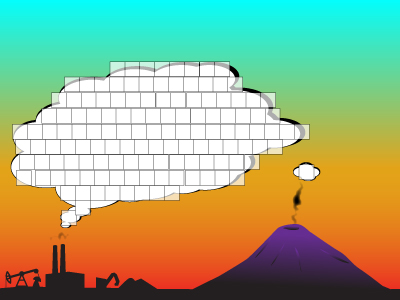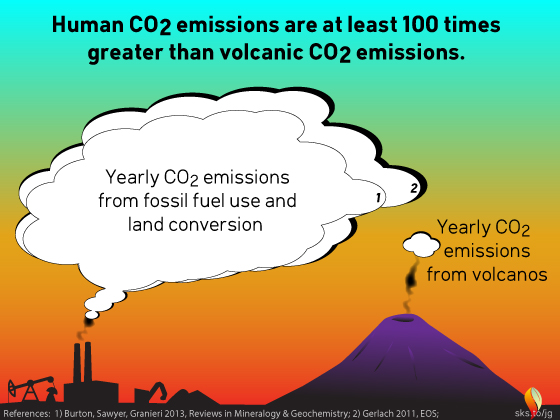Volcanic vs. Human-Caused CO2 Emissions - Updated Graphic
Posted on 8 September 2015 by jg
I create illustrations for authors of Skeptical Science posts, but lately I've had a hiatus of this activity. Some may even call it a pause, or a trend reversal. Others, however, know that there never was a pause, that the time I would have spent illustrating posts was absorbed in the deep ocean of our contribution to Denial101x. I'll be releasing some of these sequestered illustrations in our climate graphics section.
The first is a rework of our volcanic vs. human-caused emissions sketch, which appeared in "Message from the Past" by SKS author Peter Jacobs (See Denial101x 4.2.1.1). Our comparison of volcanic to anthropogenic emissions summarized Gerlach 2011 (see EOS 14 June 2011), which estimated the ratio of human emissions to volcanic at 130 to 1. Though the clouds in my drawing were metaphors, I aimed for eye-ball accuracy by drawing 131 boxes:

SKS author and geologist Andy Skuce also discussed volcanic emissions in "The CO2 Rise Is Man Made" (see DENIAL101x 3.2.2.1). Andy estimated a range from 60–120 to 1 for anthropogenic to volcanic emissions. The lower estimate (120 vs 130) is based on research by Burton, Sawyer and Granieri 2013 that estimates volcanic emissions to be higher than does Gerlach 2011, and the range (60-120) is based on whether one counts only total outgassing (60:1) or net outgassing (120:1). Consider for comparison, if a car sucked back in one half of its emissions, the net emissions from the car would be 1/2 the total. Likewise, if the production of volcanic rocks releases CO2 and then reabsorbs half of it, then the net emissions from this source is 1/2 of the total emissions.
Using net emissions, the new diagram illustrates a 100:1 ratio of human related emissions to volcanic along with the older estimate:
The 100:1 ratio understates the quantity of human emissions. It's a conservative estimate that assumes there are undiscovered natural sources. For example, much of the ocean floor is not explored, so additional sources may be found; however, as Andy explains in "The CO2 Rise is Man Made," ocean sources tend to be low emitters, so additional discoveries are not like to exonerate our fossil-fuel use.
Why not discount human emissions too? Since the biosphere and oceans absorb roughly half of our emissions, why not say the human to volcanic ratio is 50:1? Mainly because humans do not create sinks when we burn fossil fuels or manufacture cement; rather we are consuming the storage capacity of natural sinks. An exception may be emissions from land clearing for agriculture, but this is small compared to fossil fuel use.
We should be mindful that we do not know whether the storage of anthropogenic emissions in the biosphere and oceans is stable. What we put into the biosphere and ocean could be released back into the atmosphere, as when forests burn or when ocean currents warm and shift.
It is tempting to watch a volcano erupt, see it's plume in pictures taken from orbit, and think what humans are releasing is insignificant. But a long term look at the rate of volcanic to anthropogenic emissions shows that we are responsible for most of the rise of CO2. Hopefully, responsibility for our emissions will soon translate into control over them.































 Arguments
Arguments































I was wondering if co2 from volcanoes has the same raidiocarbon signature as that from burning fossilfuel.
Rolf Jander:
1) Fossil Fuel has the same C14 (radiocarbon) signature as volcanic erruptions, but a very different C13 signature.
2) Emmissions from the biosphere (respiration of animals, combustion or decomposition of plants) has the same C13 signature as fossil fuel emissions, but a very different C14 signature.
3) Between the two signatures, it is possible to possitively exclude both volcanic and biosphere emissions as the primary source of the recent in increase in atmospheric and oceanic CO2 concentration, thereby positively identifying anthropogenic emissions as the only possible cause.
This is discussed in more detail here, along with other relevant lines of evidence.
Thanks Tom, that is good to know.
Volcanoes are "like a pimple": you can quote me on that as that is how the scientists themselves regard their input to climate change if you are in the know.
@ Tom, cool!
I'm not that in the know it would seem, lol!
I just learned of another eruption - like a giant pimple - are "methane pockmarks" on the sea floor and open tundra - a few studies done. Might be another type of geological eruption. Lots of visualizations from a search on that term. I have to wonder, has this been overlooked, or underestimated?
r.pauli - This has not been overlooked, see Judd et al 2002 for an example. Their estimate is that geological sources add up to perhaps 4% of the atmospheric methane budget.
Yellowstone Park has more thermal features (geysers, steam vents, mud pools, etc) that the rest of the world combined, over 10,000, yet I bet it's out-numbered by the LA Freeway system alone, let alone every other city on the planet. Sure, volcanoes can be spectacular, but they only erupt in decadal or century intervals, the streams of vehicles are relentless, day after day, year after year.
Volcanism did cause great extinctions, via the Russian steps. So volcanism can be a great contributor. Further, volcanism might be able to destabilize clathrate, CH4 also causing great GHG effects. So, we should not discount itds potential.
This is not to disagree with the premise of the article, anthropomorphic effects to date are 131 times greater. What I am concerned with is that isostatic adjustment of the planet’s surface as ice loads change might induce greater activity in volcanism and clathrate destabilization.
When mentioned before some one recommended Bill McGuire's "Waking the Giant", which I read, thanks for the lead. This work however undercounts this potential in an effort not to seem to out there. My fear, and it is just a feeling based on energy flows on the planet, is that the potential is much greater than we know.
This discussion of the contribution to climate change is very interesting. But the associated ocean warming, toxicity and acidification should also be brought into the discussions as their influence on the operations of society will also be profound.
New York, London and the Netherlands are carrying out measures to cope with the expected sea level rise. How many other major adaption measures are under way aroung the globe?
Volcanoes also emit carbon monoxide (CO), hydrogen sulfide (H2S), carbonyl sulfide (COS), carbon disulfide (CS2), hydrogen chloride (HCl), hydrogen (H2), methane (CH4), hydrogen flouride (HF), boron, hydrogen bromine (HBr), mercury (Hg) vapor, and organic compounds. It seems at least incomplete to not address the interaction of these compounds in the atmosphere and their effect on average atmospheric temperature.
Momentarily putting aside the effects of other volcanic emmissions, a complete picture cannot emerge without addressing the following interactions concerning volcanic activity's contribution to global warming:
1) Chemical interaction of CS2 and hydrogen sulfide (H2S) at high temperatures, resulting in CO2 formation;
2) Combustion of CS2 in the presence of oxygen producing SO2 and CO2;
3) Photolysis of CS2 leading to the formation of COS, CO, and SO2, which are indirect contributors to CO2 formation;
4) One-step hydrolysis of CS2, producing reactive intermediates and ultimately forming H2S and CO2;
5) Two-step hydrolysis of CS2 forming the reactive COS intermediate that reacts with an additional water molecule, ultimately forming H2S and CO2. CS2 and COS additionally are implicated in the formation of SO2 in the stratosphere and/or troposphere.
Therefore, it is quite clear that in addition to direct volcanic CO2 emmissions, SO2 is an indirect contributor to CO2 formation and is also implicated in global climate change. However, the exact proportions in which they form during and after volcanic emmission are not know at this time. It seems a bit disingenuous to write and article minimizing the effects of volcanic activity's contribution to climate change, when the magnitude such ancillary effects is unknown.
Ignaz: "Therefore, it is quite clear that in addition to direct volcanic CO2 emmissions, SO2 is an indirect contributor to CO2 formation and is also implicated in global climate change. However, the exact proportions in which they form during and after volcanic emmission are not know at this time. It seems a bit disingenuous to write and article minimizing the effects of volcanic activity's contribution to climate change, when the magnitude such ancillary effects is unknown."
Actually, SO2, regardless of the magnitude of the contribution, is not an indirect contributor to climate change unless volcanic activity producing SO2 is riding a non-zero trend to the extent that climate is shifted. Certainly SO2 is an indirect contributor to the greenhouse effect in general, but it always has been. There's no evidence to support the claim that SO2 is playing a role in the current climate change. Perhaps you can show that the SO2 to CO2 process just started occurring 150 years ago (rather than billions of years ago).
Ignaz - As stated in the opening post, volcanic emissions are less than 1% those of anthropogenic emissions. That also holds for SO2, as major emitters of SO2 are power plants, industrial facilities, extraction of ore, and burning of high sulfur fuels (diesel).
Volcanic contributions to GHGs are minimal, and they have not changed significantly (relative to anthropogenic contributions) over the course of the Industrial Revolution. Certainly those are far outweighed by the volcanic contributions to stratospheric aerosols due to major eruptions, as seen in the data thereof:
[Source]
It seems a bit disingenuous to (as you are apparently doing) overemphasize volcanic contributions to climate change relative to anthropogenic activity. The numbers just don't support that.